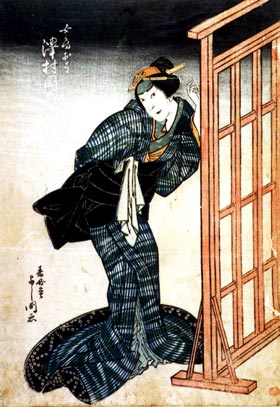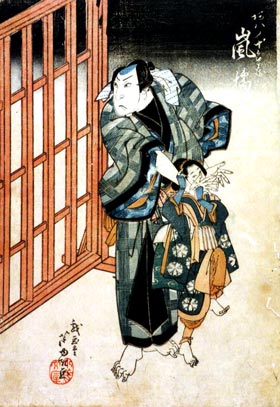| DONDORO |
| Play title | Keisei Awa no Naruto Keisei Awa no Naruto Kuni Namari Futaba no Oizuru |
| Authors | Chikamatsu Monzaemon (1695 "Keisei Awa no Naruto") Chikamatsu Hanji, Takemoto Saburobê II, Takeda Bunkichi, Terada (or Yoshida?) Heizô, Yatami Heishichi (1768 "Keisei Awa no Naruto") Nagawa Harusuke I, Nagawa Ujûrô (1808 "Kuni Namari Futaba no Oizuru") |
| History |
"Keisei Awa no Naruto" was originally written for the puppet theater (Bunraku) and staged for the first time in the 6th lunar month of 1768 in Ôsaka at the Takemotoza. The title was already used by Chikamatsu Monzaemon for a Kabuki drama, which was staged in Kyôto in the 3rd lunar month of 1695 but the 1768 "Keisei Awa no Naruto" was in fact a revision of Chikamatsu Monzaemon's drama "Yûgiri Awa no Naruto", which was staged in 1712 at the Takemotoza. Chikamatsu Hanji's "Keisei Awa no Naruto" was adapted for Kabuki and staged in the 9th lunar month of 1770 in Kyôto at the Kitagawa no Shibai [more details]. The core heroes of this play were the lovers Fujiya Izaemon and the courtesan Ôgiya Yûgiri but a subplot within the drama focused on a the story of Awa no Jûrobê and his wife Oyumi. It was so popular that it was staged as an independent drama, which was entitled "Kuni Namari Futaba no Oizuru" and was premiered at the Kita-Horie Ichi-no-Gawa Shibai in the 7th lunar month of 1808 [casting]. |
| Structure |
"Keisei Awa no Naruto" was a 10-act drama. The 8th act, divided into two scenes, "Dondoro Taishi no Monzen" (the Temple Town (monzen) near Dondoro Taishi) and "Jûrôbê Uchi" (at Jûrôbê's Home), is the only one, which is still part of both the Kabuki and Bunraku repertoires. The drama nicknamed "Dondoro" is the first scene of this 8th act. |
| Key words | Sewamono Gidayû Kyôgen Awa Dondoro Taishi Monzen Junrei Junrei Uta |
| Summary |
Introduction Jûrobê, a samurai, has taken upon himself the task of finding his master's lost sword. He moves to Ôsaka with his wife Oyumi, leaving their infant daughter in the care of her grandmother for her own safety. He joins a band of thieves to allow himself access to places where the sword might be found and has been searching for 10 years to no avail. In the scene immediately preceding the one performed, a messenger visits Oyumi who is alone at home. He brings a letter from one of Jûrobê's cohorts: their crimes have been discovered and some members of the group have been caught. Jûrobê and his wife should flee as soon as possible to escape capture. Dondoro Taishi no Monzen Shortly thereafter, Oyumi hears the songs of a Buddhist pilgrim and the ringing of a bell. A young girl on a pilgrimage has called at the house. Oyumi gives her an offering of rice and invites her in when she learns that the girl is from her own home province. The girl tells of how she is on a walking pilgrimage from distant Awa in search of her parents from whom she was separated when she was a small child. Suspicious, Oyumi asks the names of the girl's parents. Whereupon, the girl tells her they are "Jûrobê" and "Oyumi". Shocked to learn that the girl standing before her is her own daughter Otsuru, whom she had left behind years earlier, Oyumi is torn; she wants to take her beloved daughter in her arms, but if she reveals to the Otsuru that she is her mother the girl will surely be dragged into the sordid and potentially fatal affairs of her family. Oyumi fears for her daughter's life should she rejoin her parents, who may themselves be doomed. Clutching the letter she had earlier received, Oyumi vacillates but finally decides to compose herself and keep her identity secret. The purity of Otsuru's devotion to the search for her parents pierces Oyumi's heart. She waivers several times but finally decides to tell the girl that she should go back to her grandmother and await her parents' return. Touched by Oyumi's motherly compassion, the girl pleads that Oyumi might allow her to stay. Oyumi is overwhelmed by sadness but realizes that she must send Otsuru away for her own safety. She prepares some traveling money and gives it to the girl, but Otsuru will not accept it: she has enough for the road. Oyumi brushes the dust from Otsuru's kimono, then takes a hairpin and fixes Otsuru's hair before the girl turns to leave. Unable to part without seeing her one last time Oyumi calls her daughter back to her and they embrace. Otsuru grasps the end of a strip of cloth that Oyumi is holding and tries to pull her mother toward her in a highly-stylized scene that is one of the most famous in the puppet theatre. Oyumi eventually pushes Otsuru out of the house then sits stifling her sobs beside the closed door as Otsuru beats on it from the other side. Oyumi listens as Otsuru's song fades in the distance. Overcome with grief that she may never see her daughter again, Oyumi rushes out of the house to call her back. But the girl is already gone. Anguished, Oyumi is reduced to tears, but she resolves to go after her daughter. The scene ends with Oyumi standing before her house preparing to leave. Courtesy of the Bunraku Bay Puppet Troupe |
 |
 |
|
The actors Sawamura Kunitarô II, Arashi Kitsusaburô II and an unidentified child-actor playing the roles of Jûrobê's wife Oyumi, Awa no Jûrobê and Jûrobê's daughter Otsuru in the drama "Kuni Namari Futaba no Oizuru", which was staged in the 4th lunar month of 1827 at the Naka no Shibai (print made by Jukôdô Yoshikuni) |
|
|
|
| Contact | Main | Top | Updates | Actors | Plays | Playwrights | Programs | Links | FAQ | Glossary | Chronology | Illustrations | Prints | Characters | Derivatives | Theaters | Coming soon | News |